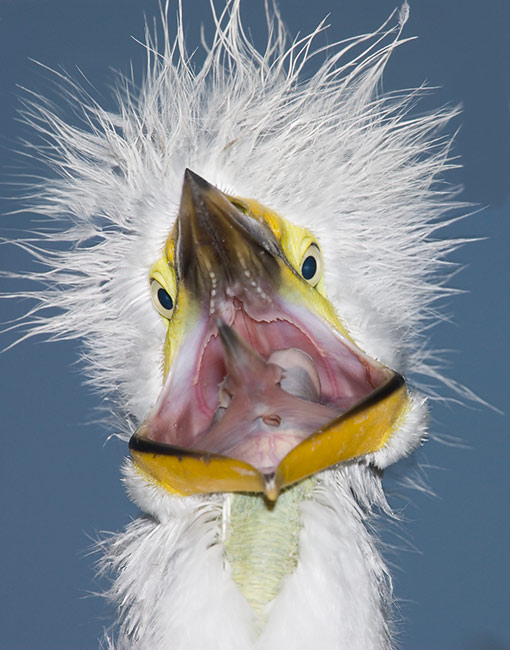
BIRDS AS ART BULLETIN 201
Visit www.birdsasart.com
IPT KUDOS
BRAND NEW IPTs ANNOUNCED
DIGITAL BASICS UPDATE AVAILABLE!
ABP II vs DIGITAL BASICS
NEW BETTER BEAMER MODELS IN STOCK AND AVAILABLE
GROUND POD PIX
R-O OFF-SHOE CORD/PAY ME NOW OR PAY ME LATER…
BLUBB UPDATE
GALAPAGOS 2007
Contact us by phone at 863-692-0906 (Eastern Time Zone) or by e-mail at birdsasart@att.net or birdsasart@verizon.net. The att address is best from overseas.
We gladly accept credit card orders by phone 8am till
You can use the Paypal links on the web site to order anything. Just type in the item(s) and the amount due. If using your own Paypal account, please send to either of the e-mail addresses above.
Photographic
Theme: My favorite images from the

Great Egret chick,
Image copyright 2006: Arthur Morris/BIRDS AS ART
Canon 500mm f/4L IS lens with 2X II TC, 25mm extension tube, and EOS 1Ds Mark II.
ISO 400. 1/250 sec. at f/25 in Manual Mode. Manual flash as Main Light at 1:4 with Better Beamer.
Here I needed to focus manually as with the 2X and the tube AF is far too slow… The white sky was darkened because of the fast shutter speed and the small aperture. Learning to use Manual Flash as main light is covered in ABP II but many folks feel that it is easier to learn it in the field. When a photographer learns to blend today’s incredible technology with impeccable technique they are capable of pretty much anything…
ST AUGUSTINE ALLIGATOR FARM IPT REPORT
The Alligator Farm was as different as I have ever seen it. The hard-working staff removed lots of non-native vegetation during the winter months so the area on the right as you first walk onto the boardwalk was pretty much devoid of nesting birds for the first 50 yards or so. The section of trees and bushes where the hanging vines are is usually packed with nests and birds. This year that area was pretty much empty except for a few pairs of Little Blue Herons and Snowy Egrets close to the boardwalk in very cluttered nests that were nearly impossible to photograph. Record numbers of Wood Storks and Great Egrets were present and afforded the best photographic opportunities. Nests of the usually easy-to-photograph smaller species, Cattle Egret, Snowy Egret, and Tricolored Heron were present in the expected numbers but as the foliage was lusher than anyone could remember, these nests were difficult or impossible to photograph. Opportunities for flight photography were excellent despite the constant blue skies. As a result, we worked very hard at perfecting our blue-sky flash-flight techniques and pretty much everyone in the group of 13 had it down pat by the end of the IPT. In addition, many folks took advantage of the opportunity to learn Manual Flash as Main Light so that long focal lengths could be used in shaded nesting situations.
Many repeat IPT participants
including Keith Kennedy, Bob and Jorja Feldman, .Kim Venhuizen, Allan Nodes, and
Jack Panzeca (8 IPTs!) joined Jim Litzenberg, Alfred Forns, Robert Amoruso (all
of whom were fantastically helpful) and me for a memorable long weekend. Van
Hill, who attended the Atlanta Seminar, joined newcomers Aaron Chandler, Layton
Parham, Vince Lamb, Marc Schoenholz, and Lori Parham in rounding out the group.
As a whole the group was amazingly talented with pretty much everyone shaking
their heads at the quality of the images presented for critiquing. We dined
in style twice a day at Gypsy Cab Company just north of the farm on the opposite
side of the street. The bad news was that there was a birding festival going on
this past weekend and the boardwalk was insanely crowded. The good news was
that except for a small handful of folks, most of the more than 100 other
photographers had absolutely no idea of how to create a good image. Bad enough
as it was watching folks work in the harsh light, even better was the fact that
none of them had ever heard of pointing your shadow at the subject to attain a
decent light angle… Most lenses were pointed at least 45 degrees off of the
shadow line. One of the main themes of the weekend was that on late spring
blue-sky days after
For the second straight IPT
the whole weekend turned pretty much into a love-fest with many of the folks
learning from and about each other. With the harsh light we spent a ton of time
in the
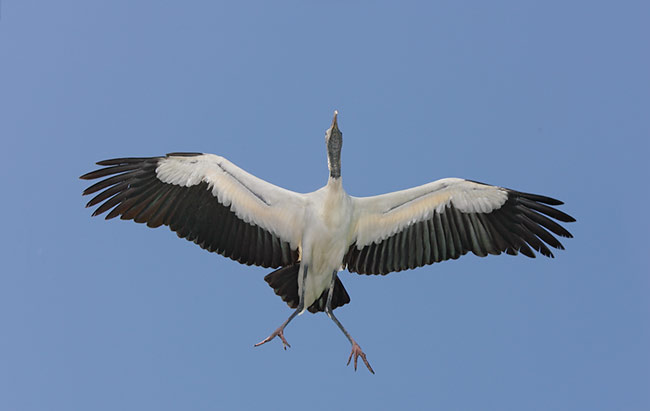
Wood Stork in flight,
Image copyright 2006: Arthur Morris/BIRDS AS ART
Canon 70-200mm f/2.8L IS lens with 1.4X II TC (handheld at 105mm) and EOS 1D Mark II N.
ISO 400. Evaluative Metering +2/3 stop: 1/500 sec. at f/8 in Tv mode. Flash as fill at +3 stops with Better Beamer.
When creating flash flight images when the sun is out the problem is to have enough flash to illuminate the undersides of the bird. It is best not to exceed 1/500 sec. when using High Speed Synch as the flash output is greatly reduced for each shutter speed stop above the synch speed, 1/250 sec. When you are at 1/500 sec., the flash has to fire twice during the exposure. At 1/1000 sec. my understanding is that it has to fire four times, and so on and so forth. For this image I chose to work in Tv mode at /1500 sec. while adding 2/3 stop of light to the exposure suggested by the camera, this to lighten the shaded undersides. The splayed legs make this one special.
IPT KUDOS
I received this e-mail from Marc Schoenholz today:
Hi Artie, Thanks for a terrific IPT at the Alligator Farm. The experience, learning, and camaraderie exceeded my expectations. Each of the three and a half days involved an incredible array of shooting opportunities, learning, fun and being with a great group of people.
As the world’s best bird photographer, you are equally blessed with your skill as an incredible teacher and mentor. From helping people find the opportunity, capture the opportunity and process the opportunity, the IPT elevates your photography skill to the next level.
If anyone is thinking about participating in an IPT, below are my top ten reasons for doing so:
10. Support from IPT assistants with unbelievable skill and a never ending willingness to help Big thanks to Alfred Forns and Robert Amoruso
9. Being able to find out everything you wanted to know about photography because you’re shooting with Artie for 3 and ½ days- Artie is there for all of the participants, all of the time.
8. Identifying/avoiding the two biggest errors in bird photography: bad light angles and bad head angles.
7. Understanding Manual Flash techniques.
6. Learning to shoot in manual mode and seeing the results real time
5. Seeing and learning how Artie creates his family jewels images in the “Birds as Art” style– capture, ingest, and Photoshop
4. Learning how to capture great images – subject, light, and composition
3. Cost/Benefit of the IPT is hard to beat – the shooting, critiquing, learning, shooting loop yields significantly improved images
2. Honest constructive feedback on your images
1. Artie Morris – the world’s Best Bird Photographer and teacher- Patience, enthusiasm, and ability to stimulate creativity
With best wishes and thanks, Marc
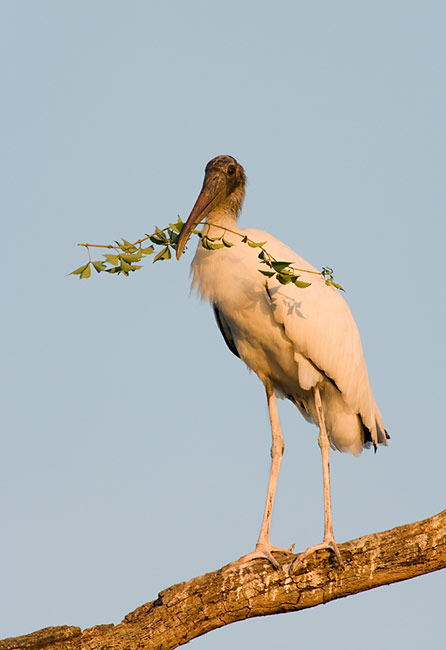
Wood Stork with nesting material,
Image copyright 2006: Arthur Morris/BIRDS AS ART
Canon 500mm f/4L IS lens with stacked 2X II TCs with EOS 1Ds Mark II.
ISO 400. Evaluative metering +1 stop: 1/160 sec. at f/11. Fill flash at -1 stop with Better Beamer.
The huge dead tree above the boardwalk can provide some great opps as the sun is setting. It is best to use long effective focal lengths to minimize the angle of inclination to the subject. In other words, do not stand under the tree with a 300mm lens pointed up at the birds.
…..
This via e-mail from DeSoto
participant Keith Kennedy whose insect photography left everyone speechless both
at DeSoto and at
Dear Artie, I just wanted to
let you know how much my family enjoyed the Fort Desoto IPT. Although it has
been more than a month since we were with you in St. Pete, we have talked about
it almost every day since (we are still waiting for summer here in
…..
An e-mail from Aaron Chandler:
Hi Artie, I wanted to take a minute and thank you again for everything. I had a great time at the Alligator Farm and learned so much from you and the others. I got some really good in flight stuff with the flash. That was a great learning experience. You and Jim run a wonderful IPT and I see now why they are so popular. Work hard, play hard; never a dull moment! Maybe I'll see you at DeSoto one morning, and I definitely want to know when the dates for the SW Florida IPT are set for next year. Take care and I'll be seeing you. Aaron
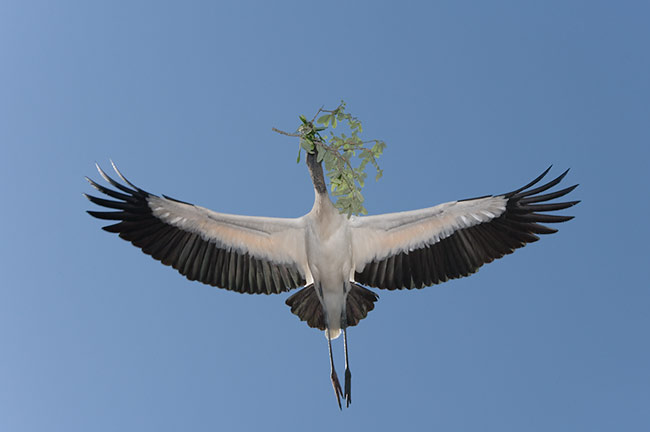
Wood Stork in flight,
Image copyright 2006: Arthur Morris/BIRDS AS ART
Canon 70-200mm f/2.8L IS lens with 1.4X II TC (handheld at 115mm) and EOS 1Ds Mark II.
ISO 400. Evaluative Metering +2/3 stop: 1/500 sec. at f/14 in set manually. Manual flash at 1:1 with Better Beamer.
Though this image has the same look as the previous flight image, a different technique was used. After determining the best ambient exposure for the lighting conditions by trial and error, that exposure was set manually. Manual Mode was selected on the 580 flash and the ration was set to 1:1. This ensured that the flash would fire at full power and illuminate the shaded undersides of the subject. In both of these images a Better Beamer was needed to concentrate the light from the flash. Had we not been using the beamers, nearly all of the images would have suffered from gross under-exposure of the underparts…
The
We are now accepting
registrations. Paypal is best but we will be glad to take your credit card
information by phone (863-692-0906) or to cash your check. If sending a check,
please make it out to “Arthur Morris” and send it to us at BIRDS AS ART,
The cost of the weekend
seminar will be $159. The cost of a single day will be $99. If you are a
member of a local camera club or natural history society, please contact me by
e-mail so that we can work out a club discount in exchange for publicity. Here
is our Cancellation Policy: BIRDS AS ART IS relying on your attendance, so if
for any reason you need to withdraw, please notify Arthur Morris ASAP. Once
we receive your e-mail, phone call, or written notice of your cancellation the
following fees apply: cancel by
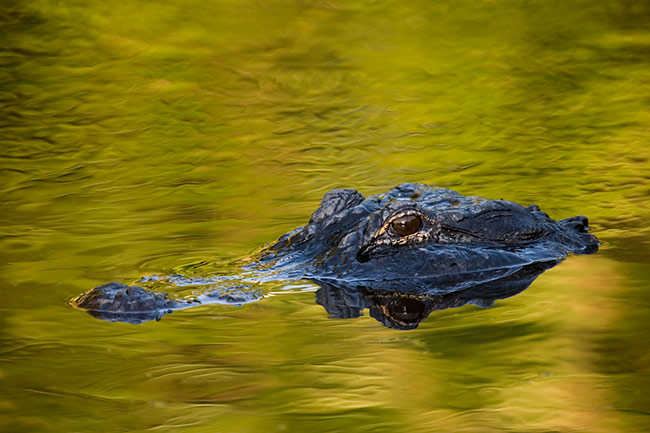
American Alligator,
Image copyright 2006: Arthur Morris/BIRDS AS ART
Canon 500mm f/4L IS lens with 2X II TC and EOS 1Ds Mark II.
ISO 800. Evaluative Metering at zero: 1/200 sec. at f/8. Fill flash at -1 stop with Better Beamer.
I
went over to Layton Parham to see if he needed any help and he was kind enough
to point out several gators floating in the surreal yellow-green water…On this
IPT I realized that one thing that separates the very good photographers from
the mediocre ones is that the very good ones do not hesitate to use their 2X
teleconverters on their big lenses and are confident that they will create sharp
images. ABP II has a section on advanced sharpness techniques illustrated by
Jim Litzenberg’s photos of yours truly in action. And remember, it ain’t just
birds! See you in
BRAND NEW IPTs ANNOUNCED
FORT DESOTO IPT: APR 13-15, 2007. Slide program on the evening of Thursday, APR 12. 3-DAY: $999 (Limit 14.)
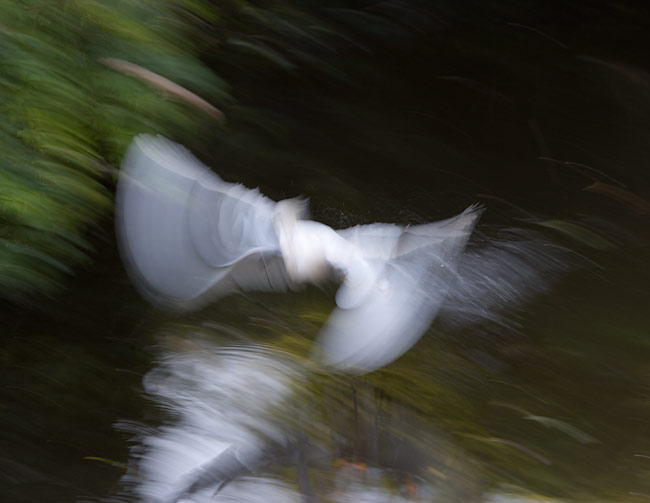
Snowy Egret flash/motion blur,
Image copyright 2006: Arthur Morris/BIRDS AS ART
Canon 70-200mm f/2.8L IS lens with1.4X II TC (handheld at 140mm) and EOS 1Ds Mark II.
ISO 50. Evaluative Metering -1 stop: 1/15 sec. at f/7.1 in Tv mode. Fill flash at -3 stops.
On the first afternoon of the pre-IPT Extension things were pretty slow and the light was harsh. There was one snowy gathering sticks right near the boardwalk. I taught several folks how to attempt to make some pleasing flash/motion blurs. Some folks were not interested (and that was fine). When they saw this image and a stunner created by Robert Amoruso who had taken my cue, they were anxious to learn the technique the very next afternoon. When conditions are not good, try thinking outside the box.
DIGITAL BASICS UPDATE AVAILABLE!
The 1800+ folks who have purchased our popular Digital Basics File should be receiving their (free) MAY 2006 update this week. New topics include leveling or straightening images, using the amazing Patch Tool, BAA Editing, Back-up, and Storage updates, exactly why and how I now use Adobe Camera Raw to convert 90% of my RAW images, and a short section on the CS2 features that I find useful. If you have paid for DB and do not receive your update by Friday, please e-mail Jennifer so that she can forward you a copy. (Many of you have new e-mail addresses that we do not know about…)
Here are two brief excerpts from the update:
Leveling With the Measure Tool
After you have opened an image, created a background copy, and noted that the image needs to be leveled, right click on the Eyedropper Tool and select the Measure Tool. Place the cursor exactly on the horizon on one side of the image then left-click and hold while dragging the line across the horizon (no need to be exact while dragging). Then place the cursor exactly on the horizon line on the opposite side of the image and release the cursor. Now click on Image/Rotate Canvas/Arbitrary. A dialogue box will appear with the necessary rotation and the correct direction. It might say .72 degrees clockwise or 1.15 degrees counterclockwise. Click OK and the image will be leveled automatically. Be patient as this may take a while with large files or slow computers. You will need to either crop or add canvas as needed once the rotation is complete.
From the section on Adobe Camera Raw Conversions:
In any case, we are now ready to begin our work with the various sliders on the Adjust tab. First, I play around with White Balance. When the image first opens, As Shot will appear in the White Balance box. The As Shot color temperature will appear in the box above the right end of Temperature slider. This slider can be thought of as the blue/ yellow slider with more blue to the left and more yellow to the right. The As Shot Tint value will be set on the slider below the Temperature slider. Think of this as the Green/Magenta slider with more green to the left and more magenta to the right. I rarely adjust the Tint slider, and when I do make an adjustment it is always only a point or two in either direction.
There are several ways to make changes to the White Balance in a given image. Before you do, make a mental note of the As Shot value so that you can know where you began. Then, move the Temperature slider a bit to the left (for colder or bluer) or a bit to the right (for warmer or yellower). You might activate the White Balance tool by clicking on it and then clicking on various light-toned portions of the image while noting the changes in the appearance of the image. It was John Shaw who told me that ACR’s White Balance tool does not work well when you click on pure whites, but that it can do pretty well when you click on the light or neutral tones. If one of the clicks strikes your fancy, you can leave that temperature setting and proceed. (Each time that you click, the new color temperature will appear in the box at the right end of the Temperature slider.) It helps to make a mental note of the color temperature setting each time that you click so that even if you do not like any of the resulting color temperatures you will be able to compare them with the As Shot value and decide if you would like to make your image a bit colder or a bit warmer.
A third approach to creating a pleasing White Balance is to click on the downward facing arrow to the right of the White Balance box and then click on one of the pre-set White Balances in the drop-down menu. Again, it pays to note the color temperature value as you click on the various pre-sets so that you can compare them to the As Shot value and decide if you might like to go for a cooler or warmer look. With roughly half my images I wind up going with the As Shot color temperature (that resulted from my setting Auto White Balance on my digital camera body). When I do change the color temperature, I most often choose one that is a bit warmer (a higher number) than the As Shot value. On rare occasion I set a color temperature that is cooler (a lower number) than the As Shot value.
To learn more about Digital Basics, click here: http://www.birdsasart.com/digitalbasics.htm
To order our Digital Basics
file ($20) you can send us a Paypal, call (863-692-0906) with your credit card
info, or send a check or money order made out to “Arthur Morris” to us at PO BOX
7245,
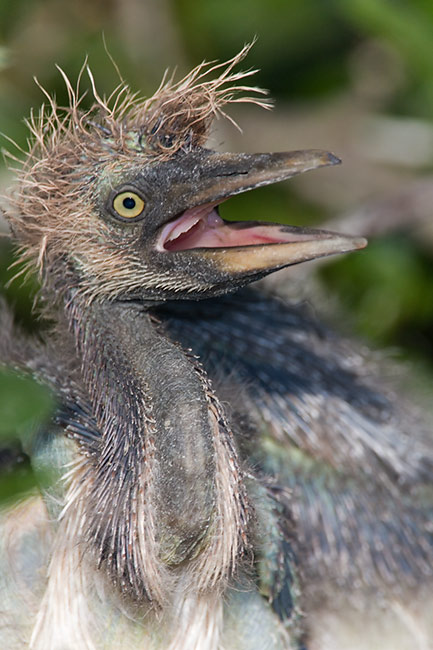
Tricolored Heron, begging chick,
Image copyright 2006: Arthur Morris/BIRDS AS ART
Canon 500mm f/4L IS lens with stacked 1.4 and 2X II TCs with EOS 1Ds Mark II.
ISO 400. 1/250 sec. at f/13 in Manual Mode. Manual flash as Main Light at 1:8 with Better Beamer.
It was almost impossible to make clean image at this nest so I went to stacked TCs in an attempt to eliminate most of the clutter. It worked! Focusing manually in situations like this is a challenge. Using flash as main light produces sharp images even at extreme focal lengths and proves that the problem is not with the quality of the optics…
ABP II vs DIGITAL BASICS
Many folks have written asking, #1: whether or not they need to order ABP II if they already have purchased Digital Basics or, #2: whether or not they need to purchase Digital Basics if they own a copy of ABPII. The answer to the first question is an absolute “Yes.” Why? ABP II contains 936 pages of solid information on bird photography. ABP II includes most—but not all of the material included in the DB Update mentioned above.
The answer to the second question is probably “Yes,” also. ABP II will not be updated. (There will, however, be future independent follow-up CD releases every 12-18 months that will contain all new information and images.) Folks who are DB subscribers (purchasers) will continue to receive updates about once a year or whenever I learn something new and exciting about Photoshop or about digital photography. For example, the MAY 2005 update mentioned above contains detailed information on converting RAW files in Adobe Camera Raw, information that does not and will not appear in ABP II.
For the folks just getting started in bird photography, do understand that we recommend that they get hold of a copy of both the soft-cover book, The Art of Bird Photography; The Complete Guide to Professional Field Techniques,” and a copy of the CD book, “The Art of Bird Photography II.” Doing so will speed the learning process by light years.
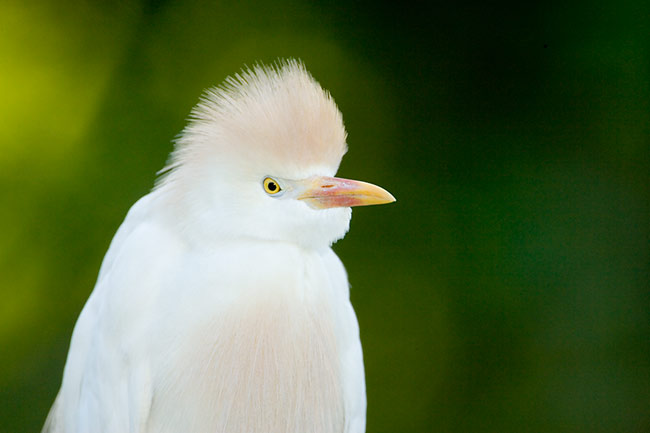
Cattle Egret in post breeding plumage, St. Augustine Alligator Farm,
Image copyright 2006: Arthur Morris/BIRDS AS ART
Canon 500mm f/4L IS lens 2X II TC and EOS 1Ds Mark II.
ISO 400. Evaluative metering at zero: 1/250 sec. at f/8 in Program mode. Fill flash at -1 stop with Better Beamer.
Images like this are usually a dime a dozen at the farm in May, but this year was different. The RAW file for this image was underexposed. It was converted in Adobe Camera Raw after making pre-conversion exposure (and other) adjustments as described in the latest update of Digital Basics.
NEW BETTER BEAMER MODELS IN STOCK AND AVAILABLE
We are now carrying the two newest Better Beamer models.
The FX-4 is custom fitted for the Nikon SB 800 and SB 600 flash units.
The FX-5 is custom-designed for the new Canon 430 EX.
(We still carry the FX-1B as it the best fit for the Nikon SB 80 and SB 80 dx flash units.)
For a complete fitting guide or to learn more about the Better Beamer flash extender (thousands sold and in use) click here: http://www.birdsasart.com/accs.html#BEAMER
All Better Beamer models are
$40.00 plus $4.00 shipping and handling. (
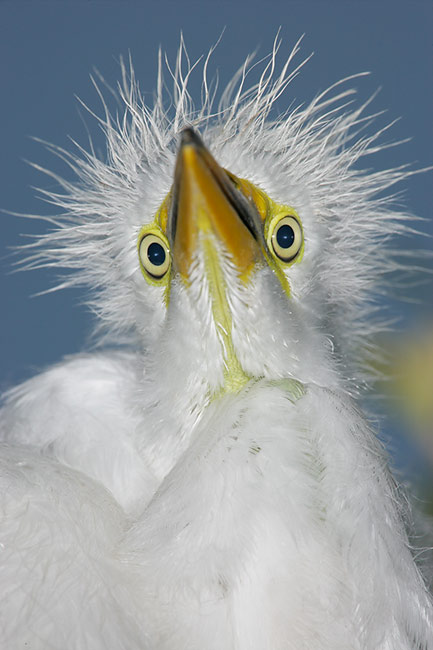
Great Egret chick,
Image copyright 2006: Arthur Morris/BIRDS AS ART
Canon 500mm f/4L IS lens with 2X II TC, 25mm extension tube, and EOS 1Ds Mark II.
ISO 400. 1/250 sec. at f/25 in Manual Mode. Manual flash as Main Light at 1:4 with Better Beamer.
One of the advantages of learning to use Manual Flash as Main Light is that once you have your settings correct you can turn out image after image with perfect exposures.
GROUND POD PIX
We have had numerous requests for photos of the Ground Pod. Here are a few.
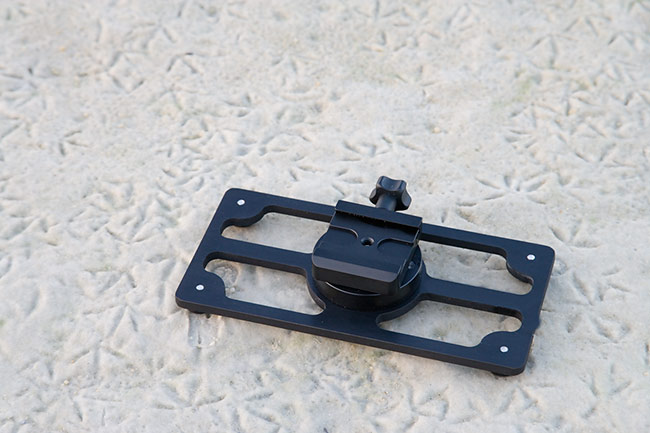
Panning Ground Pod and Dunlin footprints,
Image copyright 2006: Arthur Morris/BIRDS AS ART
Pretty creative product shot, no?
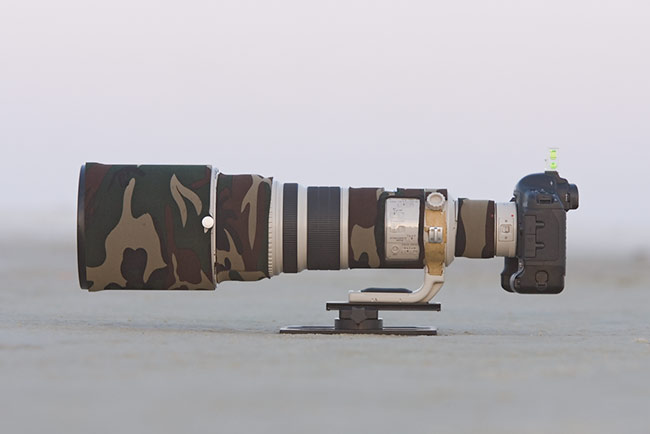
The Ground Pod and the 1Ds Mark ready for action,
Image copyright 2006: Arthur Morris/BIRDS AS ART
The Bubble Level in the hot shoe helps me create square to the world images without much hassle.
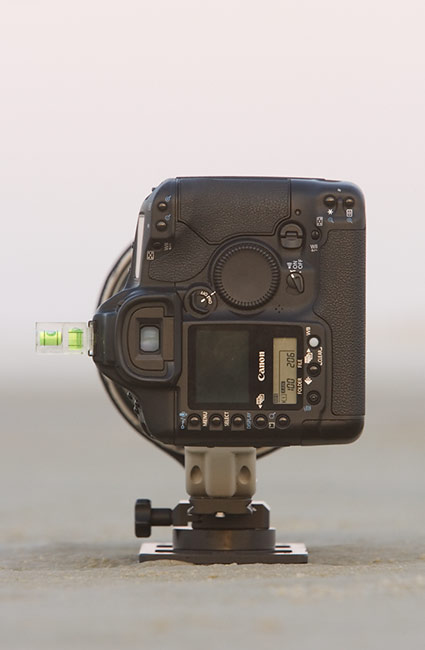
Vertical set-up for the Ground Pod,
Image copyright 2006: Arthur Morris/BIRDS AS ART
With the Ground Pod there is plenty of clearance when you are working in vertical format. Again, the bubble level is a life saver.
When you are down on the ground with your faced angled to the viewfinder, you have no idea what square to the world looks like.
R-O OFF-SHOE CORD/PAY ME NOW OR PAY ME LATER…
Many folks wrote asking what the R-O “Flash Extension Cord/Off Camera TTL” unit looks like. I have not had a chance to photograph it well yet, but wanted to let you know that it looks like a Remote Cord 2 on steroids. (Perhaps we should call it the Barry Bonds cord…)
You will need to order one of
these the next time that your Remote Cord 2 breaks, so it might be best to
simply order this sturdy version right now and avoid the inconvenience later…
They are available for $60.00 plus $4.00 shipping and handling. Overseas
customers please e-mail for additional shipping charges.
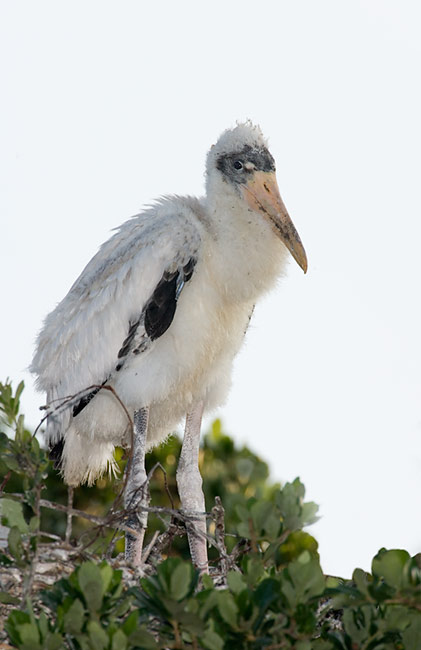
Wood Stork, grown chick,
Image copyright 2006: Arthur Morris/BIRDS AS ART
Canon 500mm f/4L IS lens with 2X II TC and EOS 1Ds Mark II.
ISO 400. Evaluative Metering +1 2/3 stops: 1/250 sec. at f/11 in Manual mode. Manual Flash at 1:8 -.7 with Better Beamer.
Photographing the storks in their nests high in the oak tree near the boardwalk ramp is a challenge. It is virtually impossible to do so when the sun it out as the light is 90 degrees to the birds in the mornings and the evenings. I wait until the sun goes down and use lots of flash and long effective focal lengths.
BLUBB UPDATE
We have sold all 160 BLUBBs that we have received thus far and are once again back-ordered. We are expecting 20 more in about 10 days but many of those are accounted for. The popularity of this fantastic new product has been even greater than I anticipated. You cannot buy a BLUBB anywhere else in the world, so if you spend a good deal of time photographing from your vehicle, your best course of action is to order a BLUBB right now. If you call with a credit card number, we will not bill your card until the product ships. To learn more about the BLUBB click here: http://www.birdsasart.com/blubb.htm.
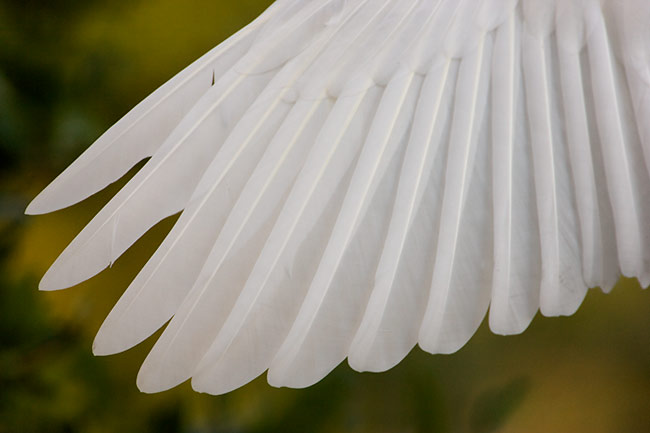
Great Egret chick, primary feathers on stretched wing,
Image copyright 2006: Arthur Morris/BIRDS AS ART
Canon 500mm f/4L IS lens with 2X II TC and EOS 1Ds Mark II.
ISO 400. Evaluative Metering +1/3 stop: 1/250 sec. at f/8 in Manual mode. Fill flash at -2 stops.
As I needed more flash and more plus compensation, I needed to optimize the exposure so that this image could reveal its potential. Why the exposure error? When the bird stretched its wing, all that I had time to do is focus and fire…
I will be doing three programs at the Great Salt Lake Bird Festival on May 19. For details and registration information visit: http://www.greatsaltlakebirdfest.com/
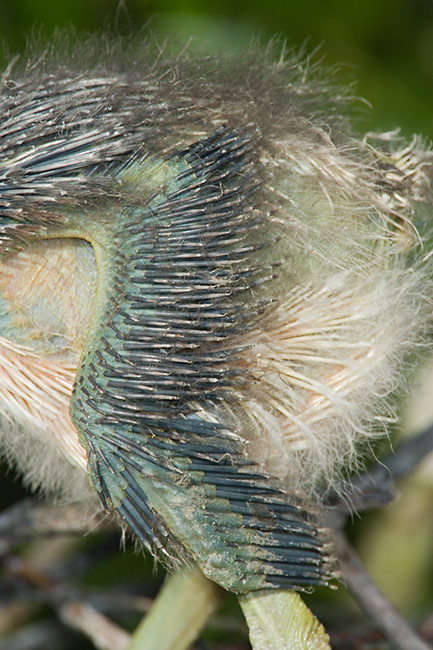
Tricolored Heron, wing of chick,
Image copyright 2006: Arthur Morris/BIRDS AS ART
Canon 500mm f/4L IS lens with stacked 1.4 and 2X II TCs with EOS 1Ds Mark II.
ISO 400. 1/250 sec. at f/13 in Manual Mode. Manual flash as Main Light at 1:8 with Better Beamer.
I love making images of stuff that few folks would even see…
GALAPAGOS 2007
I will be
leading my fourth Galapagos Photo Cruise for Distinctive Journeys,
Included:
2 nights at Colon Hilton including tax and Breakfast, 1 night at Hampton Inn
Guayaquil, city tour of Quito (an alternate day trip will be offered for a
nominal charge), all ground transfers, all inner Galapagos airfares, 7 nights
aboard the private yacht Beluga including naturalist and meals, and Galapagos
National Park entrance fees. Not included:
International airfare; please do not purchase your round trip tickets to and
from
The
cost is $4499.00 per person based on
double occupancy. A non-refundable $1200.00 per person deposit is required at
the time of booking. (Your deposit will be refunded if your slot is filled.)
Final payment is due on
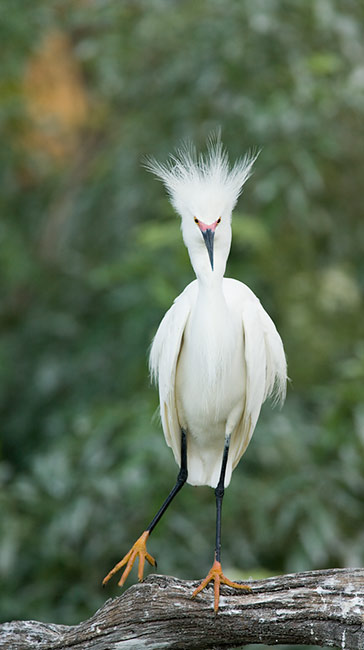
Snowy Egret displaying,
Image copyright 2006: Arthur Morris/BIRDS AS ART
Canon 500mm f/4L IS lens with 1.4 X II TC and EOS 1Ds Mark II.
ISO 400. Evaluative Metering +2/3 stop: 1/125 sec. at f/6.3. Fill flash at -1 stop with Better Beamer.
This, one of my favorite Alligator Farm perches, is well past the ramp to the Gomek shrine below the huge oak tree.
Best and love and great picture-making to all,
artie
Note: Arthur Morris has been a Canon contract photographer since 1994 and continues in that role today. Hunt's Photo of Boston, MA is a BAA sponsor as it Delkin Devices. Back issues of all BAA Bulletins can be found in the Bulletin Archives which may be accessed from the home page at www.birdsasart.com